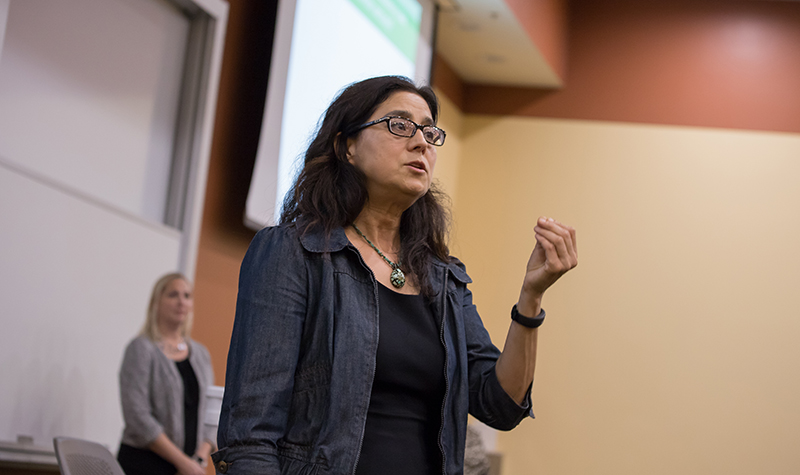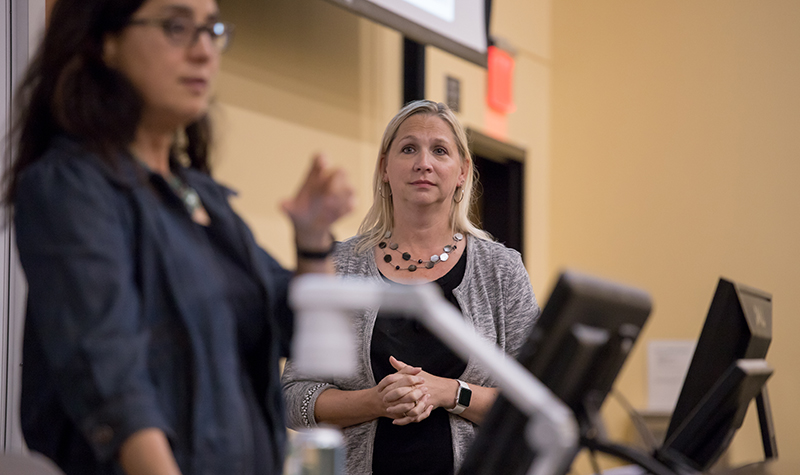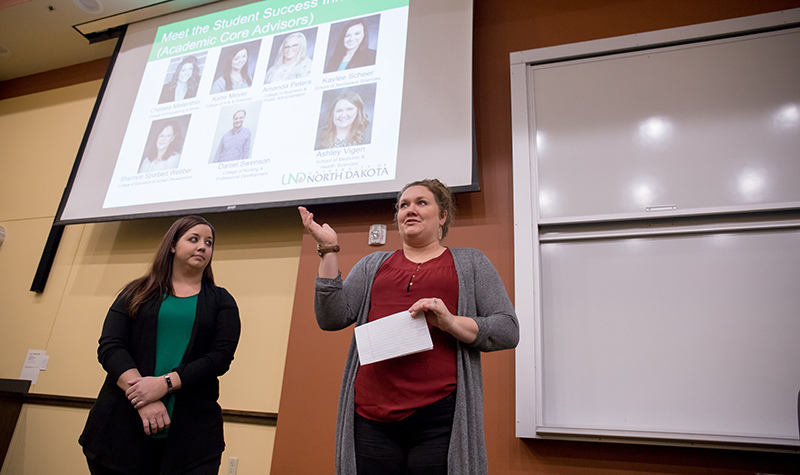21 Oct UND faculty and staff can help students think of UND as ‘my University,’ Provost’s Forum speakers say

Retention is everybody’s business at UND, said Debbie Storrs, the University’s senior vice provost for academic affairs, at the Provost’s Forum on Oct. 9. Photo by Connor Murphy/UND Today.
“So, I’m just curious,” said Debbie Storrs to the crowd of University of North Dakota faculty, staff and students, who’d gathered in a lecture hall last Wednesday for the Provost’s Forum.
“What do you think our retention rate is for first-year freshmen?”
The senior vice provost for academic affairs waited. A voice from the crowd offered: Ninety percent?
“Ninety? I’d love that!” Storrs responded. “Ninety would be good. But no.”
Eighty? asked someone else.
“Eighty? Eighty would be good, too.
“Nope.”
The correct answer is 78 percent, Storrs said. “So, think about that,” she continued.
“Students come to this campus; they’re so excited to come to UND. Right? They’re going to major in biology, or philosophy, or civil engineering, or another degree program. Yet more than 20 percent of them leave after their first year.”
That attrition is bad for those students and for the University, which makes boosting retention everyone’s business at UND, Storrs said. That’s why this academic year has been dubbed the Year of Retention; and at the Provost’s Forum, the second of 2019-20, Storrs and other speakers spelled out the strategy and invited the entire University community to take part.
Senior Seminar on retention
The presentation differed from previous descriptions of the Year of Retention in the level of detail offered. If the earlier discussions could be compared to a freshman class, this one was a senior seminar, with participants who explored the topic in depth.
Storrs began by offering a key piece of encouragement. Yes, improving retention is a big hurdle, but UND already is meeting an equally tall challenge: raising graduation rates.
“And before we get started, I just wanted to offer kudos to everybody at UND, because we’ve done an incredible job of increasing our graduation rates,” Storrs said.
“We’ve also done some work on retention. But this year, we’re going to have a laser focus on it, because that’s really where we need to spend more energy.”
And here’s why, she continued.
Retention matters for a number of key reasons. The first is the lost opportunity experienced by students who leave: “We know that students who finish their college degree have great opportunities in their communities and careers,” Storrs said. “And over their lifetimes, college graduates earn a million dollars more than their high school counterparts.
“So that lost opportunity? It’s significant.”
Second, the students who leave college without a degree are not the only ones who experience an income gap and – in too many cases – difficulty repaying student loans. Their spouses and children face hardship, too. “In my view, that means this also is a moral argument,” Storrs said.
“I always feel a moral obligation to make sure I wake up every morning thinking, ‘How can we further support student success?’”
Third, good retention numbers – like strong graduation rates – simply are a sign of a healthy university, which is why both numbers are part of Goal 2 of the One UND Strategic Plan.
And fourth, it’s more cost effective for UND to retain students than it is for the University to recruit new ones.
“So for all of those reasons, retention is hugely important,” Storrs said.
Especially because UND’s strategy to retain more students is essential to becoming a more welcoming and student-centered place.
“One of the biggest predictors of retention is that students have a sense of belonging here,” Storrs said.
“They have a connection with a faculty member, a staff member, their RA or whomever it might be. They feel like somebody cares about them. They’re not invisible, they’re not a number.”
If the University’s retention strategy were to be summed up in a single phrase, it would be this: Help all students feel like they belong at UND.
And in accomplishing that task, the faculty’s role is essential.

As Debbie Storrs finishes introducing her, Angie Carpenter, director of student academic success and career engagement at UND, stands by to address the Provost’s Forum audience. Carpenter’s office is directly involved with many of the University’s retention efforts. Photo by Connor Murphy/UND Today.
Removing obstacles
Not so many years ago, UND professors – like their counterparts at other universities – took pride in their classes’ “washout rates,” meaning how many students flunked, said Vice Provost for Online Education Jeffrey Holm at the forum.
“So there’s really a clear necessity of shifting that idea.” And the point is not to relax the classes’ rigor, but to strive toward making sure that as many – not as few – students as possible master the material.
That starts with removing needless obstacles, such as textbook costs, in many cases. UND has an extensive program of Open Educational Resources, which are high-quality teaching, learning and research materials that are available for free.
Stephanie Walker, Dean of Libraries, shared that the only difference — surprisingly — between many courses taught with OERs and those with traditional textbooks has not been the students’ grades or knowledge gained. Instead, the difference has been in how many more students dropped the textbook-centered classes versus the classes that used OERs. Many students, it seems, start a class without buying the expensive textbook, because they’re hoping that the professor won’t use the volume, Walker said. Then when the chapter assignments start rolling in, the students drop the class.
That makes OERs a retention issue.
Here’s another hurdle for students: not enough support in “high risk courses” or “high DFW classes” — those in which high percentages of students get grades of D, F or W (withdrew).
UND is addressing that issue with targeted tutoring, said Angie Carpenter, director of student academic success and career engagement.
“Essentially, we’re really digging in and being intentional about how our tutoring program works,” Carpenter said. “That means we’re looking specifically at those high DFW courses on campus, and we’re making sure we’re aligning our tutors with them.”
This way, students who are struggling can get help right away. And that’s vital in difficult classes, because students who fall behind in, say, calculus often have a hard time catching up.
The list of retention-focused programs and procedures goes on:
Five Step Career Prep, UND Career Services’ program to encourage all students to visit the office at least five times. UND’s Core Advisors — “student success innovators” is Provost Tom DiLorenzo’s term – who, on the job since January, have been tasked with making a difference on retention.
The newly established transfer coordinator, who’ll help make transferring into UND as easy and seamless as possible. The Starfish program, with its continuing refinements that alert faculty, advisors and the student ever more graciously and efficiently if the student’s grades or attendance lag.
These and other programs described at the forum can be summed up with Angie Carpenter’s word: “intentional.” They are intentional efforts to boost retention by making UND a more caring place. They are intentionally building the sense of belonging that makes such a difference in students’ decisions to stay.
And throughout the forum, speakers told story after story of how personal attention by faculty and staff matter in retention, too.

UND’s academic core advisors such as Katie Meyer (left) and Ashley Vigen form a network of advisors that links colleges across campus, boosting opportunities for — and retention of — students. Photo by Connor Murphy/UND Today.
Our students
For example, when financial, grade and other pressures brought one student to the verge of capsizing, thoughtful intervention by the Registar’s Office, a chair of a department, and key faculty members – brought together by Shannon Sporbert Webber, one of UND’s academic core advisors – helped that student right the ship.
“There was lots of back and forth, and my interactions with the student were as a professional nag,” Sporbert Webber said, drawing laughter from the audience.
“The student did the work, and the offices on campus did the work. It really was a collaborative effort.
“And all I had to do – all the Registrar’s Office and the academic department had to do – was to see the student as our student. Not ‘this office can help you’ or ‘that office can help you’; no.
“I can help you. This was our student, and this was just a team of people who saw the student that way: as our responsibility.”
That’s the Year of Retention in a nutshell, Sporbert Webber said.


